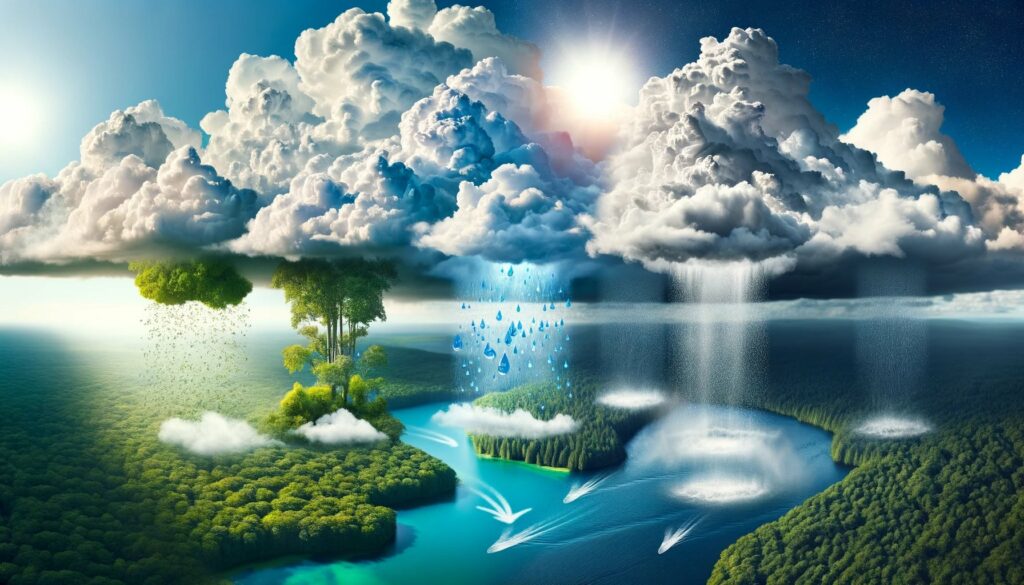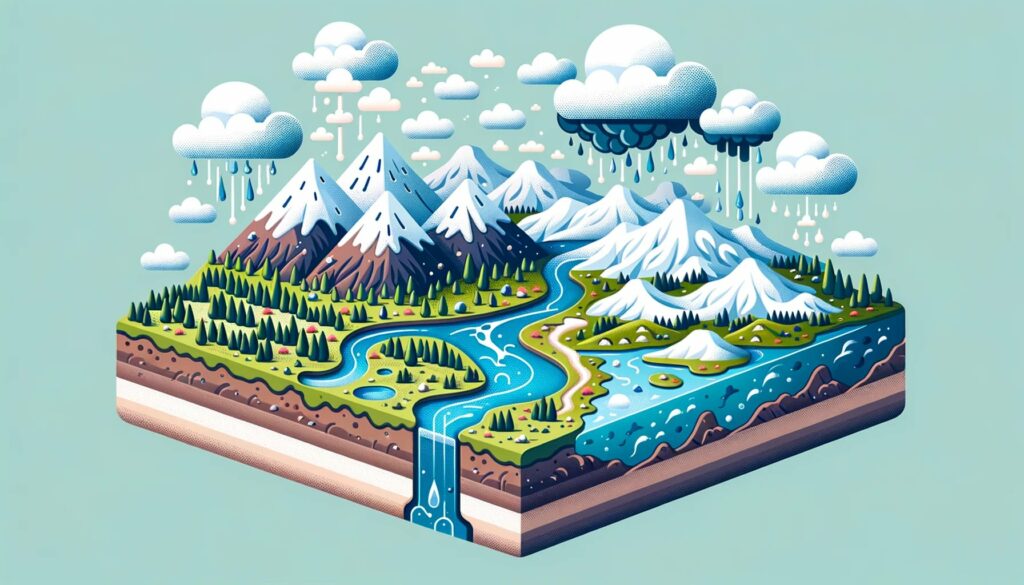Precipitation is a crucial element within the GCSE water cycle, and its significance cannot be overstated. As droplets of water fall from the atmosphere to the Earth’s surface, they play a vital role in replenishing our freshwater resources and sustaining life as we know it. In this article, we will unravel the mysteries of precipitation, exploring its mechanisms, importance, and the impact it has on our daily lives.
Understanding Precipitation in the GCSE Water Cycle: Key Component Explained
Precipitation is a fundamental process in the GCSE water cycle that plays a crucial role in maintaining the Earth’s water balance. It is the method by which water is recycled in the atmosphere, ensuring the replenishment of our freshwater resources. In this article, we will delve into the wonders of precipitation and explore its significance in the grand scheme of the water cycle.
What Exactly is Precipitation in the GCSE Water Cycle?
Precipitation refers to any form of water particles that fall from the atmosphere and reach the Earth’s surface. This includes rain, snow, sleet, and hail. Precipitation occurs when the air cannot hold any more moisture, leading to the release of excess water particles back to the ground.
The Role of Precipitation in the Water Cycle
Imagine a world without precipitation. Waterways would quickly dry out, leaving us with limited freshwater resources. The water cycle, which relies on precipitation, would come to a halt. It is through precipitation that water is recycled and redistributed across the Earth.
Precipitation is the driving force behind the replenishment of our freshwater supplies. Surprisingly, less than 1% of the Earth’s water is easily accessible to us, and much of that water is replenished through precipitation. This highlights the critical role that precipitation plays in maintaining our water resources.
How Does Precipitation Work in the GCSE Water Cycle?
The process of precipitation begins with evaporation, where heat from the sun causes water from various sources such as oceans, lakes, and rivers to change from a liquid state to a gas or vapor. This water vapor eventually rises into the atmosphere.
As the warm moisture-laden air rises higher into the atmosphere, it cools down. This cooling causes the water vapor to condense into tiny droplets or ice crystals. These droplets or crystals then come together to form clouds.
Once the clouds become saturated with moisture, the excess water particles come together, forming larger droplets or ice crystals. Eventually, these droplets or crystals become heavy enough to fall back to the Earth’s surface as precipitation.
The Impact of Precipitation on Our Daily Lives
Precipitation affects every living thing on Earth. It provides vital water for agriculture, sustains ecosystems, and ensures the availability of drinking water for humans and animals alike. Precipitation is responsible for filling our reservoirs, lakes, and rivers, ultimately supporting our livelihoods and the survival of various species.
Rainfall, in particular, can have different effects depending on its intensity and duration. Gentle showers can nurture crops and replenish groundwater reserves, while heavy downpours can lead to flooding and soil erosion. Understanding the patterns of precipitation helps us prepare for these outcomes and adapt to their impacts.
In Conclusion
Precipitation is a key component of the GCSE water cycle, playing a significant role in refreshing our water supplies and maintaining the balance of our planet. It not only sustains life but also shapes our environment. From gentle rainfall to fluffy snowflakes, precipitation is an awe-inspiring process that continues to fascinate scientists and ignite curiosity in all of us.
So, the next time you observe raindrops falling from the sky or build snowmen after a snowfall, remember the incredible journey of precipitation in the magnificent water cycle of our planet.
The water cycle is an extraordinary process that governs the movement and distribution of water on our planet. One crucial component of this cycle is precipitation. Precipitation occurs when water vapor in the atmosphere condenses into droplets or ice crystals and falls to the Earth’s surface. This natural phenomenon plays a vital role in replenishing our water sources and sustaining the delicate balance of ecosystems. Understanding the intricacies of precipitation and its connection to the water cycle is crucial for comprehending the broader dynamics of our planet’s hydrological system. To delve deeper into the captivating world of precipitation and the water cycle, click here.
The Role of Precipitation in the Water Cycle
Precipitation, a key component of the water cycle, plays a vital role in maintaining the delicate balance of water on Earth. It connects the ocean, land, and atmosphere, ensuring the continual circulation and distribution of freshwater. In this article, we will explore the importance of precipitation in the GCSE water cycle and gain a deeper understanding of its significance in our daily lives.
The Water Cycle: A Continuous Journey
The water cycle is a continuous journey that water takes through various stages, including evaporation, condensation, precipitation, and runoff. Precipitation, specifically, refers to any form of water particles that fall from the atmosphere and reach the Earth’s surface. It includes rain, snow, sleet, and hail.
The Ins and Outs of Precipitation
Precipitation is responsible for depositing fresh water on our planet, replenishing and sustaining freshwater sources. Less than 1% of Earth’s water is easily accessible, and precipitation is a crucial process that refills our reservoirs, lakes, and rivers. It brings life-sustaining water to agriculture, allows ecosystems to thrive, and supports the availability of drinking water.
The Birth of Clouds and Raindrops
The process of precipitation begins with evaporation, where heat from the sun causes water to change from a liquid state to a gas or vapor. This vapor rises into the atmosphere and cools, eventually condensing into droplets or ice crystals, forming clouds. As these clouds become saturated, the excess water particles come together to form larger droplets or ice crystals. These larger particles then fall under the force of gravity as precipitation.
The Impact on Our Daily Lives
Precipitation affects every living thing on Earth. It shapes our environment, drives natural processes, and influences various aspects of our daily lives. By understanding precipitation patterns, scientists and meteorologists can predict weather conditions, helping us prepare for and adapt to its impacts. Different intensities and durations of rainfall can have different effects, nurturing crops one minute and causing flooding or soil erosion the next.
The Lifecycle of Water: a Never-Ending Story
The water cycle is a fascinating and never-ending story that continuously repeats itself. The role of precipitation in this cycle is essential, showcasing how water transforms and circulates through different states and locations. From the formation of clouds to the release of raindrops, precipitation plays a critical role in maintaining the Earth’s water balance and supporting life as we know it.
Conclusion
In conclusion, precipitation is a fundamental process in the water cycle. It completes the circle by transporting water vapor from the atmosphere back to the Earth’s surface. The role of precipitation in the GCSE water cycle cannot be overstated. It replenishes freshwater sources, sustains ecosystems, and impacts various aspects of our daily lives. So, the next time you witness raindrops falling, remember the crucial role precipitation plays in maintaining the delicate balance of our planet’s water resources.
Examples and Impact of Precipitation on the Environment and Human Activities
Precipitation, a fundamental aspect of the water cycle, has a remarkable impact on both the environment and human activities. In this article, we will explore various examples of how precipitation influences our surroundings and daily lives.
1. Essential for Agriculture
Precipitation plays a crucial role in supporting agriculture and ensuring food production. The right amount and timing of rainfall are essential for healthy crop growth. For example, insufficient precipitation can hinder crop development and lead to drought conditions, affecting farmers’ livelihoods and food availability. On the other hand, excessive rainfall can cause waterlogging, root suffocation, and soil erosion, negatively impacting agricultural productivity.
2. Impact on Ecosystems
Precipitation significantly influences ecosystems, shaping biodiversity and maintaining delicate natural balances. Different ecosystems have different precipitation requirements, and any alteration can result in significant consequences. For instance, forests depend on adequate rainfall to sustain their vitality, contributing to the overall health of the ecosystem. A decrease in precipitation can lead to drought-induced forest dieback, affecting habitat availability for countless organisms.
Conversely, heavy precipitation events, such as tropical storms and hurricanes, can cause devastating effects, including flooding, mudslides, and habitat destruction. These events not only endanger plant and animal populations but also disrupt delicate ecological relationships, potentially leading to long-term ecological changes.
3. Water Resource Management
Precipitation forms the foundation of freshwater resources, sustaining rivers, lakes, and groundwater reservoirs that serve as vital water sources for human activities. Changes in precipitation patterns directly impact water availability and quality, affecting various sectors such as drinking water supply, industry, and hydropower generation.
In areas with erratic precipitation, water scarcity becomes a pressing issue, impacting communities’ access to clean water. On the other hand, excessive precipitation can overload water infrastructure, leading to floods that damage infrastructure, disrupt transportation, and jeopardize public safety.
4. Climate Change and Extreme Precipitation Events
Human activities, particularly through greenhouse gas emissions and land use change, have altered precipitation patterns, leading to more frequent and intense extreme precipitation events. These events have tangible consequences for human societies and the environment.
Floods, triggered by heavy rainfall or prolonged precipitation, can cause extensive property damage, displacement of communities, and loss of life. Landslides, another result of intense rainfall, pose serious threats to hilly or mountainous regions, with devastating consequences for both human settlements and ecosystems.
5. Impact on Urban Areas
In urban areas, precipitation can pose significant challenges due to impervious surfaces such as concrete and asphalt. These surfaces limit natural absorption and increase surface runoff, which can overwhelm drainage systems and lead to flash flooding. Urban planning and infrastructure design must consider precipitation patterns to ensure effective stormwater management, reduce the risk of flooding, and enhance urban resilience.
6. Recreation and Tourism
Precipitation influences outdoor recreational activities, such as hiking, skiing, and fishing. For example, adequate precipitation is essential for healthy river ecosystems that support various fish species, providing opportunities for fishing enthusiasts. Conversely, drought-induced reductions in river flow can impact fishing experiences and lead to the decline of fish populations.
In winter tourism destinations, snowfall is crucial for skiing and snowboarding enthusiasts, as well as the local economy. Changes in precipitation patterns, such as a decrease in snowfall or increased instances of rain instead of snow, can directly impact the success of such activities and economic stability in these regions.
Conclusion
Precipitation plays a profound role in the functioning of our planet and the well-being of both the environment and human society. From its vital contribution to agriculture and ecosystems to its influence on water resources, climate change, urban areas, and recreational activities, precipitation’s impact is far-reaching and inescapable.
Understanding the examples and impact of precipitation on the environment and human activities is essential for raising awareness, shaping sustainable practices, and preparing for future challenges associated with our changing climate. By recognizing the significance of precipitation, we can work towards harnessing its benefits while minimizing its negative repercussions.
FAQ
Question 1: What is precipitation in the GCSE water cycle?
Answer: Precipitation in the GCSE water cycle refers to the process of water falling from the atmosphere to the Earth’s surface. It includes rain, snow, sleet, and hail, and is an essential component of the water cycle as it replenishes freshwater sources.
Question 2: Why is precipitation important in the water cycle?
Answer: Precipitation plays a vital role in recycling the water in the Earth’s atmosphere. Without precipitation, waterways would quickly dry out, and the water cycle would not be able to repeat. It replenishes freshwater sources and ensures the availability of water for various ecosystems and human needs.
Question 3: How does precipitation affect the environment?
Answer: Precipitation affects every living thing on Earth. It delivers water to plants, animals, and humans, enabling their survival. Additionally, extreme precipitation events caused by human activity and climate change, such as flooding and landslides, can have significant consequences for ecosystems and human societies.
Question 4: What factors contribute to changes in precipitation patterns?
Answer: Several factors contribute to changes in precipitation patterns. Human activities, such as greenhouse gas emissions, land use change, burning of fossil fuels, agricultural practices, and deforestation, increase the concentration of greenhouse gases, affect the Earth’s average temperature, and subsequently influence precipitation patterns.
Question 5: How is precipitation connected to the global water cycle?
Answer: Precipitation is a major part of the global water cycle, along with evaporation and condensation. It delivers water from the atmosphere to the Earth’s surface and is responsible for replenishing freshwater sources. The distribution of precipitation is influenced by the climate system, as well as atmospheric and ocean circulation.


















